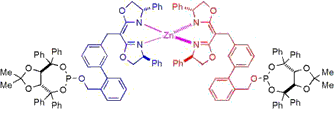Chemistry, Department of: Faculty Series

James M. Takacs Publications
Document Type
Article
Date of this Version
December 2003
Abstract
This paper describes the design, synthesis, and successful employment of inhibitors of 4-( β -D-ribofuranosyl) aminobenzene-5’-phosphate (RFA-P) synthase, which catalyzes the first committed step in the biosynthesis of methanopterin, to specifically halt the growth of methane-producing microbes. RFA-P synthase catalyzes the first step in the synthesis of tetrahydromethanopterin, a key cofactor required for methane formation and for one-carbon transformations in methanogens. A number of inhibitors, which are N-substituted derivatives of p-aminobenzoic acid (pABA), have been synthesized and their inhibition constants with RFA-P synthase have been determined. Based on comparisons of the inhibition constants among various inhibitors, we propose that the pABA binding site in RFA-P synthase has a relatively large hydrophobic pocket near the amino group. These enzyme-targeted inhibitors arrest the methanogenesis and growth of pure cultures of methanogens. Supplying pABA to the culture relieves the inhibition, indicating a competitive interaction between pABA and the inhibitor at the cellular target, which is most likely RFAP synthase. The inhibitors do not adversely affect the growth of pure cultures of the bacteria (acetogens) that play a beneficial role in the rumen. Inhibitors added to dense ruminal fluid cultures (artificial rumena) halt methanogenesis; however, they do not inhibit volatile fatty acid (VFA) production and, in some cases, VFA levels are slightly elevated in the methanogenesisinhibited cultures. We suggest that inhibiting methanopterin biosynthesis could be considered in strategies to decrease anthropogenic methane emissions, which could have an environmental benefit since methane is a potent greenhouse gas.


Comments
APPLIED AND ENVIRONMENTAL MICROBIOLOGY, Dec. 2003, p. 7236–7241 Vol. 69, No. 12. Copyright © 2003, American Society for Microbiology. Permission to use.